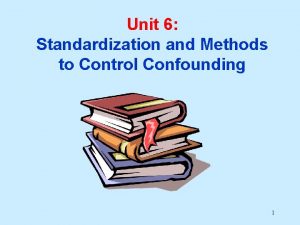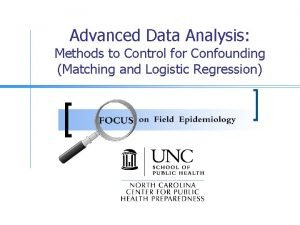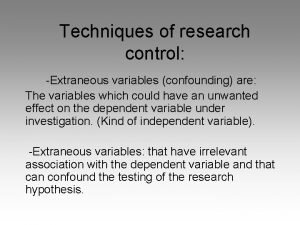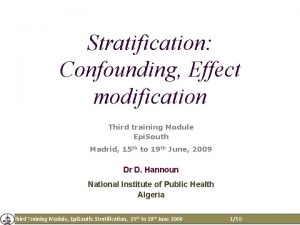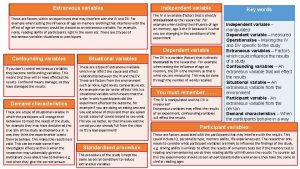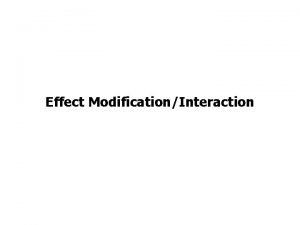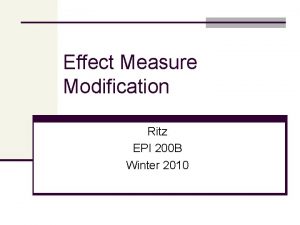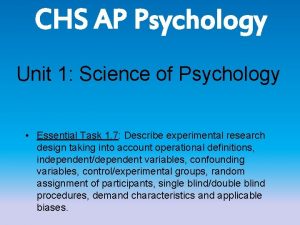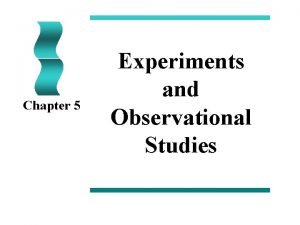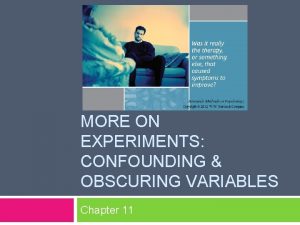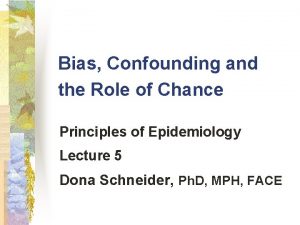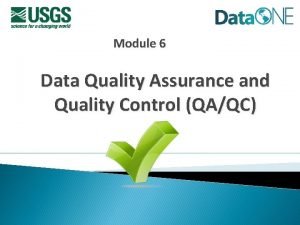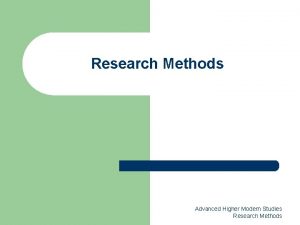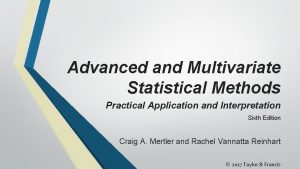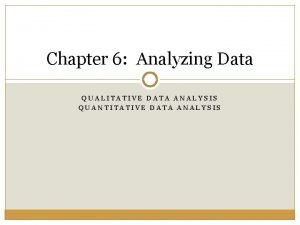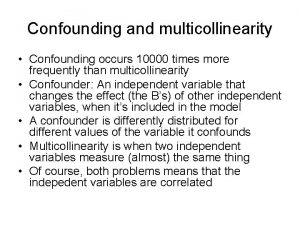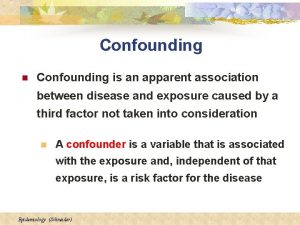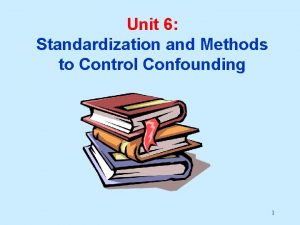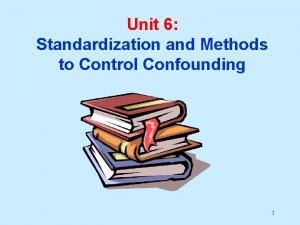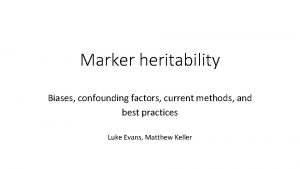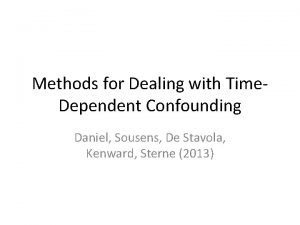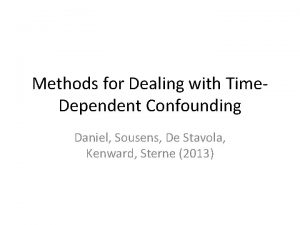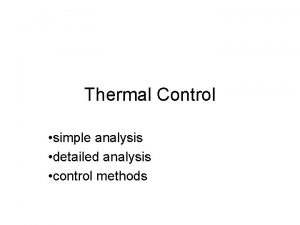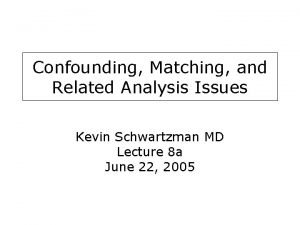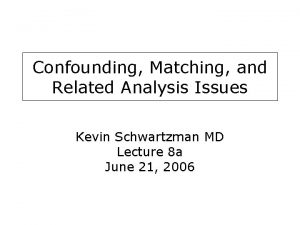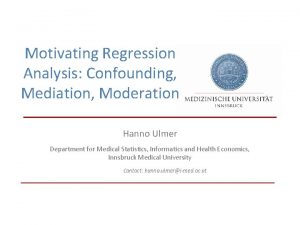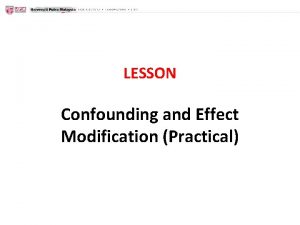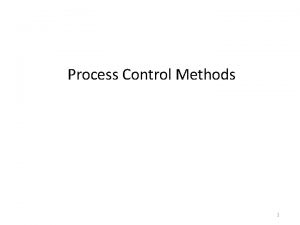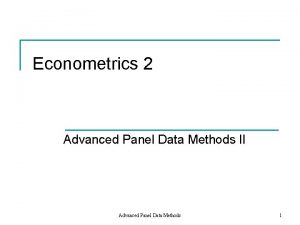Advanced Data Analysis Methods to Control for Confounding
















































- Slides: 48

Advanced Data Analysis: Methods to Control for Confounding (Matching and Logistic Regression)

Goals n n Understand the issue of confounding in statistical analysis Learn how to use matching and logistic regression to control for confounding

Confounding n Example: people in a gastrointestinal outbreak n n Mostly members of the same dinner club BUT many club members also went to a city-wide food festival Food handling practices in the dinner club might be blamed for the outbreak when food eaten at the festival was the cause Membership in the dinner club could be a confounder of the relationship between attendance at the food festival and illness Analyzing the data to account for both dinner club membership and food festival attendance could help determine which event was truly associated with the outcome

Confounding n Gastrointestinal outbreak (continued) n n Stratification methods could be used to calculate the risk of illness due to the food festival for those in the dinner club vs. those not in the dinner club If attending the food festival was a significant risk factor for illness in both groups, then the festival would be implicated because illness occurred whether or not people were members of the dinner club

Confounding n What if there are multiple factors that might be confounding the exposure-disease relationship? n n n Using our previous example, what if we had to stratify by membership in the dinner club and by health status? Or stratify by other potential confounders (age, occupation, income, etc. )? Trying to stratify by all of these layers becomes difficult At this point more advanced methods are needed: n n Logistic regression – controls for many potential confounders at one time Matching – when incorporated correctly into the study design, reduces confounding before analysis begins

Confounding Confounders n In field epidemiology, we commonly compare two groups by using measures of association: n n n Risk ratio (RR) in cohort studies Odds ratio (OR) in case-control studies May have multiple exposures significantly associated with disease or no exposures associated n In these cases you need to explore whether a confounder is present making it appear that exposures are associated with the disease (when they really are not) or making it appear that no association exists (when there really is one)

Confounders n A confounder is a variable that distorts the risk ratio or odds ratio of an exposure leading to an outcome n n n Confounding is a form of bias that can result in a distortion in the measure of association between an exposure and disease Confounding must be eliminated for accurate results (1) Confounding can occur in an observational epidemiologic study whenever two groups are compared to each other n Confounding is a “mixing of effects” when the groups are compared (exposure-disease relationship can be affected by factors other than the relationship)

Common Confounders n n Common confounders include age, socioeconomic status and gender. Examples: n Children born later in the birth order are more likely to have Down’s syndrome. n n n Does birth order cause Down’s syndrome? No—relationship is confounded by mother’s age, older women are more likely to have children with Down’s Mother’s age confounds the association between birth order and Down’s syndrome: appears there is an association when there is not (2)

Common Confounders--Examples n Women’s use of hormone replacement therapy (HRT) and risk of cardiovascular disease n n n Some studies suggest an association, others do not Women of higher socio-economic status (SES) are more likely to be able to afford HRT Women of lower SES are at higher risk of cardiovascular disease Differences in SES may thus confound the relationship between HRT and cardiovascular disease Need to control for SES among study participants (3)

Common Confounders--Examples n Hypothetical outbreak of gastroenteritis at a restaurant n n Study shows women were at much greater risk of the disease than men Association is confounded by eating salad—women were much more likely to order salad than men Salad was contaminated with disease-causing agent Relationship between gender and disease was confounded by salad consumption (which was the true cause of the outbreak)

Characteristics of Confounders n Confounders must have two key characteristics: n n A confounder must be associated with the disease being studied A confounder must be associated with the exposure being studied

Controlling for Confounding n n To control for confounding you must take the confounding variable out of the picture There are 3 ways to do this: n Restrict the analysis—analyze the exposure-disease relationship only among those at one level of the confounding variable n n Stratify—analyze the exposure-disease relationship separately for all levels of the confounding variable n n Example: look at the relationship between HRT and cardiovascular disease ONLY among women of high SES Example: look at the relationship between HRT and cardiovascular disease separately among women of high SES and low SES Conduct logistic regression—regression puts all the variables into a mathematical model n Makes it easy to account for multiple confounders that need to be controlled

Controlling for Confounding: Stratification n n Stratification can be used to separate the effects of exposures and confounders Example: tuberculosis (TB) outbreak among homeless men n Homeless shelter and soup kitchen implicated as the place of transmission Men likely to spend time in both places To determine which site is most likely, could examine the association between the homeless shelter and TB among men who did NOT go to the soup kitchen and among men who DID go to the soup kitchen

Stratification--Example n Outbreak at a reception, cookies and punch have both been implicated n n Suspicion that one food item is confounding the other Cannot tease out the effects without stratifying because many people consumed both cookies and punch

Stratification--Example n After conducting a case-control study, overall data show the following: Cookie Exposure Cases Controls Total Cookies 37 21 58 No Cookies 13 29 42 Total OR = (37 x 29)/(21 x 13) = 3. 93; 95% CI, 1. 69 – 9. 15 p= 0. 001* n 100

Stratification--Example n Data continued…. . Punch Exposure Cases Controls Total Punch 40 20 60 No Punch 10 30 40 Total OR = (40 x 30)/(20 x 10) = 6. 00; 95% CI, 2. 83 – 12. 71 p= 0. 0004* n 100

Stratification--Example n n Both cookies and punch have a high odds ratio for illness & a confidence interval that does not include 1 n OR (cookies) = 3. 93; 95% CI, 1. 69 – 9. 15, p= 0. 001* n OR (punch) = 6. 00; 95% CI, 2. 83 – 12. 71, p= 0. 0004* To stratify by punch exposure, we want to know: n n n Among those who did not drink punch, what is the odds ratio for the association between cookies and illness? Among those who did drink punch, what is the odds ratio for the association between cookies and illness? If cookies are the culprit, there should be an association between cookies and illness, regardless of whether anyone drank punch

Stratification--Example n Stratification of the cookie association by punch exposure: Did have punch Cases Cookies No Cookies Controls Total 35 17 52 5 3 8 Total OR = (35 x 3)/(17 x 5) = 1. 3; 95% CI, 0. 17 – 7. 22 p= 1. 0* n 60

Stratification--Example n Stratification of the cookie association by punch exposure: Did not have punch Cases Controls Total Cookies 2 4 6 No Cookies 8 26 34 Total OR = (2 x 26)/(4 x 8) = 1. 63; 95% CI, 0. 12 – 13. 86 p= 0. 63* n 40

Stratification--Example n To stratify by cookie exposure, we want to know: n n n Among those who did not eat cookies, what is the odds ratio for the association between punch and illness? Among those who did eat cookies, what is the odds ratio for the association between punch and illness? If punch is the culprit, there should be an association between punch and illness, regardless of whether anyone ate cookies

Stratification--Example n Stratification of the punch association by cookie exposure: Did have cookies Cases Punch No Punch Controls Total 35 17 52 2 4 6 Total 58 OR = (35 x 4)/(17 x 2) = 4. 12; 95% CI, 0. 52 – 48. 47 p= 0. 18* n

Stratification--Example n Stratification of the punch association by cookie exposure: Did not have cookies Cases Controls Total Punch 5 3 8 No Punch 8 26 34 Total OR = (5 x 26)/(3 x 8) = 5. 42; 95% CI, < 0. 80 – 40. 95 p= 0. 08* n 42

Stratification n Stratification allows us to examine two risk factors independently of each other In our cookies and punch example we can see that cookies were not really a risk factor independent of punch (stratified ORs ≈ 1) Punch remained a potential risk factor independent of cookies (large ORs and pvalues close to significant)

More on Stratification n Mantel-Haenszel odds ratio n n n Method of controlling for confounding using stratified analysis Takes an association, stratifies it by a potential confounder and then combines these by averaging them into one estimate that is “controlled” for the stratifying variable Cookies and punch example: n n 2 stratum-specific estimates of the association between punch and illness (ORs of 4. 1 and 5. 4) More convenient to have only one estimate—can average two estimates into a pooled or common odds ratio

Stratification and Effect Measure Modifiers n Effect measure modification n n One stratum shows no association (OR ≈ 1) while another stratum does have an association No confounding third variable present, rather, need to identify and present estimates separately for each level or stratum Example: if gender is an effect measure modifier, you should give 2 odds or risk ratios, 1 for men and 1 for women You identify effect measure modification by stratification (same technique used to identify confounding) but you are looking for the measure of effect to be different between the 2 or more strata

Effect Measure Modifiers-Examples n Among the elderly, gender is an effect modifier of the association between nutritional intake and osteoporosis n n n Nutritional intake (calcium) is associated with osteoporosis among women Among men this association is not so strong because men’s bone mineral content is not affected as much by nutritional intake In developing countries, sanitation is an effect modifier of the association between breastfeeding and infant mortality n n In unsanitary conditions, breastfeeding has a strong effect in reducing infant mortality In cleaner conditions infant mortality is not very different between breastfed and bottle-fed infants

Matching n Matching can reduce confounding n n In case-control studies cases are matched to controls on desired characteristics In cohort studies unexposed persons are matched to exposed persons on desired characteristics You must account for matching when analyzing matched data Important that the matched variables not be exposures of interest

Matching--Example n Hypothetical study where students in a high school have reported a strange smell and sudden illness n n Test the association between smelling an unusual odor and a set of symptoms Match cases and controls on gender, grade and hallway n n Precedents for ‘outbreaks’ of illness related to unusual odors in buildings, possibly psychogenic (ie. illness spread by panic rather than true cause) Women are more reactive in this situation, grade level controls for age (different ages may react differently) and matching on hallway controls for actual odor observed (different locations may produce different odors)

Matching--Example n. With matched case-control pairs, a 2 x 2 table is set up to examine pairs Table 1: Analysis of matched pairs for a case control study Controls Cases Exposed Not Exposed Total Exposed e f e + f Not Exposed g h g + h e + g f + h Total n n n Cells e and h are concordant cells because the case and the control have the same exposure status Cells f and g are discordant because the case and control have a different exposure status Only the discordant cells give us useful data to contrast the exposure between cases and controls

Matching--Example n A chi-square for matched data (Mc. Nemar’s chi -square) can be calculated using a statistical computing program n n Calculation examines discordant pairs and results in a Mc. Nemar chi-square value and p-value If the p-value <0. 05, you can conclude that there is a statistically significant difference in exposure between cases and controls

Matching--Example n A table of discordant pairs can also be used to calculate a measure of association Table 2: Sample data for sudden illness in a high school. Controls matched to cases on gender, grade, and hallway in the school Controls Smell Cases No Smell Total Smell 6 12 18 No Smell 4 5 9 10 17 Total

Matching--Example n Calculating the odds ratio: OR = (# pairs with exposed cases and unexposed cases) (# pairs with unexposed cases and exposed controls) = f / g = 12/4 = 3. 0 n Interpretation: n The odds of having a sudden onset of nausea, vomiting, or fainting if students smelled an unusual odor in the school were 3. 0 times the odds of having a sudden onset of these symptoms if students did not smell an unusual odor in the school, controlling for gender, grade, and location in the school.

Matching n An important note about matching: n n n Once you have matched on a variable, you cannot use that variable as a risk factor in your analysis Cases and controls will have the exact same matched variables so they are useless as risk factors Do not match on any variable you suspect might be a risk factor

An Introduction to Logistic Regression n Logistic regression is a mathematical process that results in an odds ratio Logistic regression can control for numerous confounders The odds ratio produced by logistic regression is known as the “adjusted” odds ratio because its value has been adjusted for the confounders

An Introduction to Logistic Regression n n Outcome variable (sick or not sick) and exposure variable (exposed or not exposed) must both be dichotomous Other variables (the confounders) can be dichotomous, categorical, or continuous

An Introduction to Logistic Regression n Logistic regression uses an equation called a logit function to calculate the odds ratio Using our earlier punch and cookies example, we suspect one of these food items is confounding the other Variables would be: n n n SICK (value is 1 if ill, 0 if not ill) PUNCH (1 if drank punch, 0 if did not drink punch) COOKIES (1 if ate cookies, 0 if did not eat cookies)

Logistic Regression--Example n General equation is: n n Logit (OUTCOME) = EXPOSURE + CONFOUNDER 1 + CONFOUNDER 2 + CONFOUNDER 3 + … (etc) For our example: n n Outcome = variable SICK Exposure = variable PUNCH Confounder = variable COOKIES Equation is: Logit (SICK) = PUNCH + COOKIES

Logistic Regression--Example n n Computer uses the math behind logistic regression to give the results as odds ratios Each variable on the right side will have its own odds ratio n n Odds ratio for PUNCH would be the odds of becoming ill if punch was consumed compared to the odds of becoming ill if punch was not consumed, controlling for COOKIES Odds ratio for COOKIES is the odds of becoming ill if cookies were consumed compared to the odds of becoming ill if cookies were not consumed, controlling for PUNCH

Logistic Regression: Important Points n Each variable on the right side of the equation is controlling for all the other variables on the right side of the equation n n If you are not sure whether one of several variables is a confounder, you can examine them all at the same time Two important warnings: n n Do not put too many variables in the equation (a loose rule of thumb is you can add one variable for every 25 observations) You cannot control for confounders you did not measure (Example: if a child’s attendance at a particular daycare was a confounder of the SICK-PUNCH relationship, but you do not have data on children’s daycare attendance, you cannot control for it. )

Logistic Regression & Matching n Logistic regression can also account for matching in the data analysis n n Known as conditional logistic regression Computer calculates odds ratios similar to Mc. Nemar’s test but the results are “conditioned” on the matching variables Can be done using Epi Info Interpretation of matched odds ratios (MORs) using conditional logistic regression is the same as interpretation of MORs calculated from tables

Logistic Regression n For many investigations you may not need to use logistic regression Logistic regression is helpful in managing confounding variables, useful with large datasets and in studies designed to establish risk factors for chronic conditions, cancer cluster investigations or other situations with numerous confounding factors Many software packages can simplify data analysis using logistic regression n SAS, SPSS, STATA and Epi Info are a few examples

Logistic Regression: Software Packages n Common software packages used for data analysis, including logistic regression* n n n SAS – Cary, NC http: //www. sas. com/index. html SPSS – Chicago, IL http: //www. spss. com/ STATA –College Station, TX http: //www. stata. com Epi Info –Atlanta, GA http: //www. cdc. gov/Epi. Info/ Episheet – Boston, MA http: //members. aol. com/krothman/modepi. htm (Episheet cannot do logistic regression but is useful for simpler analyses, e. g. , 2 x 2 tables and stratified analyses. ) *This is not a comprehensive list, and UNC does not specifically endorse any particular software package.

Logistic Regression--Examples n Wedding Reception, 1997 (4) n n Guests complained of a diarrheal illness diagnosed as cyclosporiasis Univariate analysis (using 2 x 2 tables) showed eating raspberries was the exposure most strongly associated with risk for illness Multivariate logistic regression showed same results Investigators determined raspberries had not been washed

Logistic Regression--Examples n Assessing the relationship between obesity and concern about food security (5) n n n Washington State Dept. of Health analyzed data from the 1995 -99 Behavioral Risk Factor Surveillance System A variable indicating concern about food security was analyzed using a logistic regression model with income and education as potential confounders Persons who reported being concerned about food security were more likely to be obese than those who did not report such concerns (adjusted OR = 1. 29, 95% CI: 1. 04 -1. 83)

Matching & Conditional Logistic Regression--Examples n Foodborne Salmonella Newport outbreak, 2002 (6) n n n Affected 47 people from 5 different states Case-control study carried out, controls matched by agegroup Logistic regression conducted to control for confounders Cases were more likely than controls to have eaten ground beef (MOR = 2. 3, 95% CI: 0. 9 -5. 7) and more likely to have eaten raw or undercooked ground beef (MOR = 50. 9, 95% CI: 5. 3 -489. 0) No specific contamination event identified but public health alert issued to remind consumers about safe food-handling practices

Matching & Conditional Logistic Regression--Examples n Outbreak of typhoid fever in Tajikistan, 1996 -97 (7) n n n 10, 000 people affected in outbreak, case-control study conducted Cases were culture positive for the organism (Salmonella serotype Typhi) Using 2 x 2 tables, illness was associated with: n n Drinking unboiled water in the 30 days before onset (MOR = 6. 5, 95% CI: 3. 0 -24. 0) Using drinking water from a tap outside the home (MOR = 9. 1, 95% CI: 1. 6 -82. 0) Eating food from a street vendor (MOR = 2. 9, 95% CI: 1. 4 -7. 2) When all variables were included in conditional logistic regression, only drinking unboiled water (MOR = 9. 6, 95% CI: 2. 7 -334. 0) and obtaining water from an outside tap (MOR = 16. 7, 95% CI: 2. 0138. 0) were significantly associated with illness n Routinely boiling drinking water was protective (MOR = 0. 2, 95% CI: 0. 05 -0. 5)

Conclusion n n Controlling for confounding can be done using matched study design and logistic regression While complicated, with practice these methods can be as easy to use as 2 x 2 tables

References 1. 2. 3. 4. 5. Gregg MB. Field Epidemiology. 2 nd ed. New York, NY: Oxford University Press; 2002. Hecht CA, Hook EB. Rates of Down syndrome at livebirth by one-year maternal age intervals in studies with apparent close to complete ascertainment in populations of European origin: a proposed revised rate schedule for use in genetic and prenatal screening. Am J Med Genet. 1996; 62: 376 -385. Humphrey LL, Nelson HD, Chan BKS, Nygren P, Allan J, Teutsch S. Relationship between hormone replacement therapy, socioeconomic status, and coronary heart disease. JAMA. 2003; 289: 45. Centers for Disease Control and Prevention. Update: Outbreaks of Cyclosporiasis -- United States, 1997. MMWR Morb Mort Wkly Rep. 1997; 46: 461 -462. Available at: http: //www. cdc. gov/mmwr/PDF/ wk/mm 4621. pdf. Accessed December 12, 2006. Centers for Disease Control and Prevention. Self-reported concern about food security associated with obesity --- Washington, 1995— 1999. MMWR Morb Mort Wkly Rep. 2003; 52: 840 -842. Available at: http: //www. cdc. gov/mmwr/preview/mmwrhtml/mm 5235 a 3. htm. Accessed December 12, 2006.
 How to control for confounding variables in regression
How to control for confounding variables in regression Why control for confounding variables
Why control for confounding variables Effect modifier vs confounder
Effect modifier vs confounder What is extraneous variables in research
What is extraneous variables in research Effect modification vs confounding
Effect modification vs confounding Berkensonian bias
Berkensonian bias What is extraneous variables
What is extraneous variables Strongest research design
Strongest research design Confounding vs effect modification
Confounding vs effect modification Effect modification vs confounding
Effect modification vs confounding Effect modification vs confounding
Effect modification vs confounding Effect modification epidemiology
Effect modification epidemiology Confounding variable psychology
Confounding variable psychology Confounding variable
Confounding variable Obscuring variable
Obscuring variable Misclassification bias
Misclassification bias Explain quality control
Explain quality control Preengineered building
Preengineered building Advanced business research methods
Advanced business research methods Advanced higher modern studies essay structure
Advanced higher modern studies essay structure Advanced and multivariate statistical methods
Advanced and multivariate statistical methods Data analysis methods
Data analysis methods Input and output design
Input and output design Inlay wax pattern fabrication
Inlay wax pattern fabrication Jelaskan tentang error control pada data link control?
Jelaskan tentang error control pada data link control? Hijacking attacks
Hijacking attacks Advanced vehicle control
Advanced vehicle control Iso 22301 utbildning
Iso 22301 utbildning Typiska novell drag
Typiska novell drag Tack för att ni lyssnade bild
Tack för att ni lyssnade bild Returpilarna
Returpilarna Varför kallas perioden 1918-1939 för mellankrigstiden?
Varför kallas perioden 1918-1939 för mellankrigstiden? En lathund för arbete med kontinuitetshantering
En lathund för arbete med kontinuitetshantering Kassaregister ideell förening
Kassaregister ideell förening Tidbok för yrkesförare
Tidbok för yrkesförare Sura för anatom
Sura för anatom Vad är densitet
Vad är densitet Datorkunskap för nybörjare
Datorkunskap för nybörjare Stig kerman
Stig kerman Debattartikel struktur
Debattartikel struktur Magnetsjukhus
Magnetsjukhus Nyckelkompetenser för livslångt lärande
Nyckelkompetenser för livslångt lärande Påbyggnader för flakfordon
Påbyggnader för flakfordon Arkimedes princip formel
Arkimedes princip formel Publik sektor
Publik sektor Bo bergman jag fryser om dina händer
Bo bergman jag fryser om dina händer Presentera för publik crossboss
Presentera för publik crossboss Vad är ett minoritetsspråk
Vad är ett minoritetsspråk Kanaans land
Kanaans land
